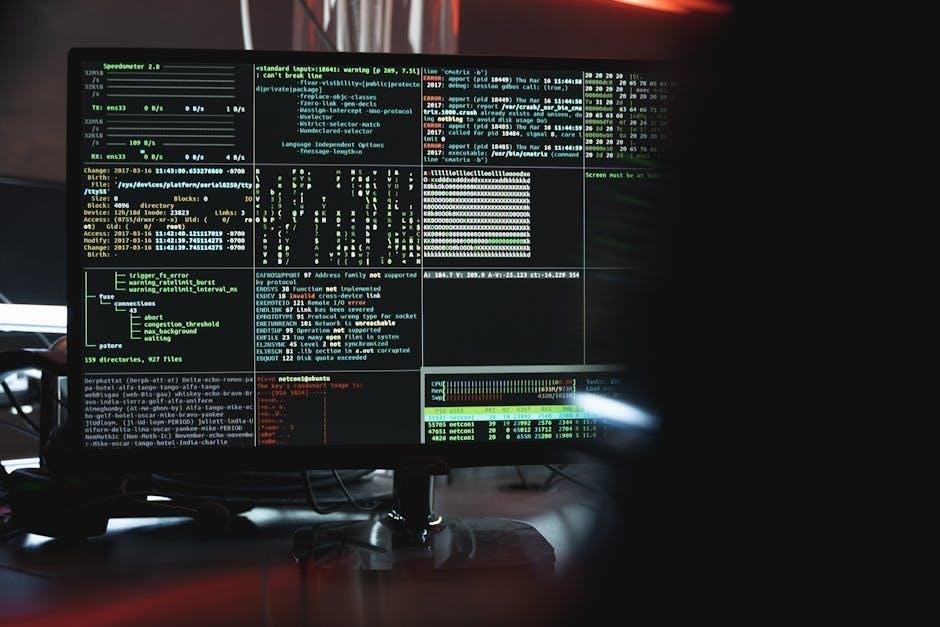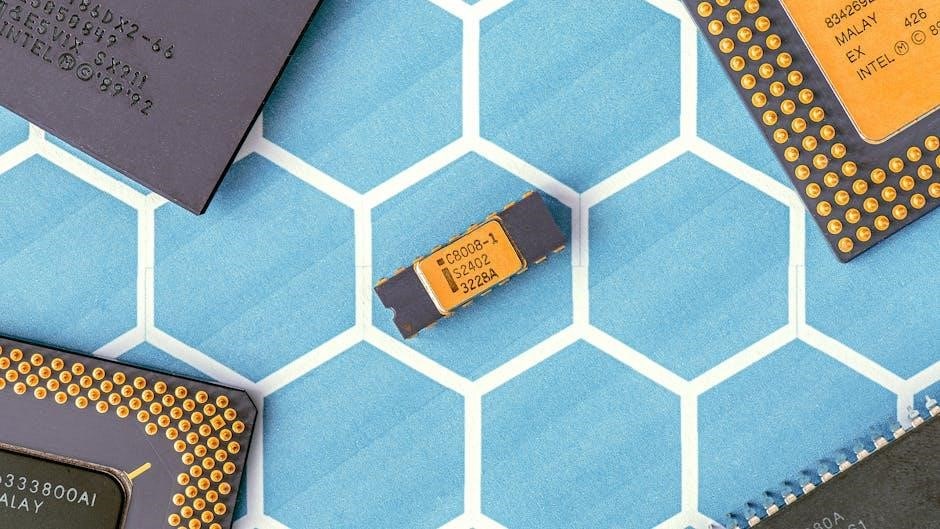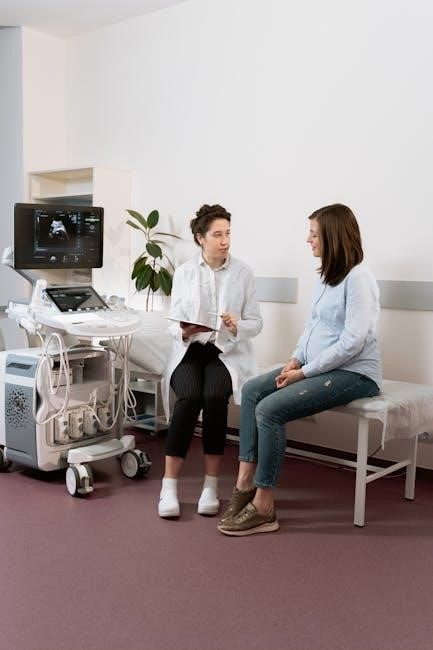Transrectal ultrasound-guided prostate biopsy is a common diagnostic procedure for detecting prostate cancer. It combines ultrasound imaging with biopsy needle placement‚ using CPT codes 55700‚ 76872‚ and 76942 for billing.
Overview of the Procedure
Transrectal ultrasound-guided prostate biopsy is a minimally invasive procedure used to diagnose prostate cancer. It involves inserting an ultrasound probe into the rectum to visualize the prostate gland. Under real-time ultrasound guidance‚ a biopsy needle is directed to suspicious areas to collect tissue samples. This technique ensures precise targeting of abnormal tissues identified during the ultrasound. The procedure is typically performed in an outpatient setting and requires minimal preparation. It combines imaging and biopsy in a single session‚ allowing for accurate diagnosis while minimizing discomfort. CPT codes 55700‚ 76872‚ and 76942 are used to bill for the biopsy‚ imaging‚ and needle guidance‚ respectively‚ ensuring comprehensive reimbursement for the procedure.
Importance of CPT Coding in Medical Billing
Accurate CPT coding is essential for proper billing and reimbursement in medical procedures like transrectal ultrasound-guided prostate biopsy. CPT codes ensure standardized reporting of services‚ facilitating seamless communication between healthcare providers and payers. Specific codes such as 55700 for the biopsy‚ 76872 for ultrasound imaging‚ and 76942 for needle guidance are critical for capturing the full scope of the procedure. Proper coding prevents denial of claims‚ reduces administrative delays‚ and ensures fair compensation for services rendered. It also aids in tracking procedure volumes and outcomes‚ contributing to quality improvement initiatives. Adherence to coding guidelines is vital for compliance with regulations and maintaining accurate patient records. Effective use of CPT codes streamlines the billing process‚ benefiting both providers and patients.

CPT Codes for Transrectal Ultrasound Guided Prostate Biopsy
Key CPT codes include 55700 for the biopsy‚ 76872 for transrectal ultrasound imaging‚ and 76942 for ultrasound guidance during needle placement.
CPT Code 55700: Prostate Biopsy by Any Technique
CPT code 55700 is used for reporting a prostate biopsy performed through any technique‚ including transrectal‚ transperineal‚ or endoscopic methods. This code encompasses the entire procedure‚ from needle insertion to tissue sampling‚ and is essential for billing purposes in medical practices. It is often billed alongside imaging codes like 76872 for ultrasound imaging and 76942 for guidance‚ ensuring comprehensive reimbursement for both the procedure and imaging services. Accurate documentation is crucial to avoid billing errors and ensure compliance with Medicare and other payer guidelines. This code is widely recognized and standardized‚ making it a cornerstone in urological billing for prostate biopsies.
CPT Code 76872: Transrectal Ultrasound Imaging
CPT code 76872 specifically refers to transrectal ultrasound imaging of the prostate and seminal vesicles. This code is used to bill for the diagnostic imaging portion of the procedure‚ capturing high-resolution images essential for guiding the biopsy needle. It is often utilized in conjunction with 76942‚ which covers ultrasound guidance for needle placement‚ ensuring accurate tissue sampling. Documentation must clearly describe the imaging services provided to justify the use of this code. Medicare and other payers typically cover this code up to two times annually‚ emphasizing the importance of adhering to utilization guidelines to avoid denial of claims. Proper coding ensures reimbursement for the critical imaging component of prostate biopsy procedures.
CPT Code 76942: Ultrasound Guidance for Needle Placement
CPT code 76942 is used to report ultrasound guidance for needle placement during procedures like prostate biopsy. This code captures the technical component of using real-time ultrasound imaging to direct the biopsy needle accurately into the target tissue. It is commonly billed alongside 76872 for transrectal ultrasound imaging and 55700 for the biopsy procedure itself. According to NCCI guidelines‚ 76942 is bundled with 76872‚ meaning they cannot be separately reported for the same procedure. Accurate documentation of the ultrasound guidance is essential for proper reimbursement‚ as Medicare and other payers require clear justification for the use of this code. Proper coding ensures that the technical aspects of the procedure are appropriately reimbursed‚ reflecting the critical role of ultrasound guidance in precise needle placement during prostate biopsy.

Clinical Applications of Transrectal Ultrasound Guided Biopsy
Transrectal ultrasound-guided biopsy is primarily used for diagnosing prostate cancer‚ monitoring high-risk patients‚ and guiding therapeutic interventions‚ ensuring accurate tissue sampling and targeted treatment planning.
Diagnosis of Prostate Cancer
Transrectal ultrasound-guided prostate biopsy is a critical tool in diagnosing prostate cancer. It allows for precise tissue sampling under real-time imaging‚ ensuring accurate detection of malignancies. The procedure is often recommended for men with elevated PSA levels or suspicious digital rectal exam findings. Using CPT codes 55700‚ 76872‚ and 76942‚ the process involves imaging the prostate gland‚ identifying suspicious areas‚ and guiding the biopsy needle to collect tissue samples. This method enhances diagnostic accuracy‚ enabling early detection and timely treatment of prostate cancer. It is widely regarded as the standard of care for diagnosing prostate cancer due to its effectiveness and minimally invasive nature.
Monitoring Prostate Health in High-Risk Patients
Transrectal ultrasound-guided prostate biopsy plays a vital role in monitoring prostate health‚ particularly for high-risk patients. Men with a family history of prostate cancer‚ elevated PSA levels‚ or suspicious imaging results benefit from regular surveillance. The procedure allows for the early detection of abnormalities‚ enabling timely intervention. CPT codes 55700‚ 76872‚ and 76942 are used to bill for this procedure‚ ensuring accurate reimbursement for the diagnostic and monitoring services provided. Regular monitoring helps identify changes in the prostate gland‚ reducing the risk of cancer progression. This approach is essential for managing high-risk patients and improving long-term outcomes through early detection and appropriate treatment planning.
Guiding Therapeutic Interventions
Transrectal ultrasound-guided prostate biopsy is not only diagnostic but also aids in guiding therapeutic interventions. The precise imaging provided by ultrasound allows for accurate targeting of suspicious areas‚ facilitating effective tissue sampling. This precision is crucial for planning treatments such as brachytherapy or focal therapy. CPT codes 55700‚ 76872‚ and 76942 are used to bill for these procedures‚ ensuring proper documentation of both diagnostic and therapeutic aspects. By combining real-time imaging with needle guidance‚ clinicians can deliver targeted treatments‚ enhancing patient outcomes. This dual-role capability makes the procedure invaluable in both diagnosing and managing prostate conditions‚ offering a comprehensive approach to patient care.

Alternative Techniques and Corresponding CPT Codes
Alternatives include transperineal biopsy (CPT 55706) and MRI-ultrasound fusion biopsy (CPT 77021)‚ offering distinct approaches for prostate tissue sampling with specific coding requirements.
Transperineal Ultrasound Guided Biopsy
Transperineal ultrasound-guided biopsy involves accessing the prostate through the perineum‚ reducing infection risks. CPT code 55706 is used for this procedure‚ which often includes imaging guidance. Unlike transrectal methods‚ it avoids rectal complications‚ making it safer for certain patients. This technique is particularly favored in high-risk cases or when repeat biopsies are needed. The use of stereotactic templates enhances accuracy‚ ensuring comprehensive sampling. Documentation must clearly describe the approach and any imaging used to ensure accurate billing. This method is gaining popularity due to its safety profile and diagnostic efficacy‚ offering a valuable alternative to traditional transrectal biopsies.
MRI-Ultrasound Fusion Biopsy
MRI-ultrasound fusion biopsy combines magnetic resonance imaging (MRI) with real-time ultrasound to guide prostate tissue sampling. This technique enhances accuracy by targeting suspicious areas identified on MRI. It is particularly useful for patients with prior negative biopsies or complex prostate anatomy. CPT code 77021 is used for MRI guidance‚ while CPT code 55706 may apply for saturation biopsy. Although considered investigational‚ this method offers improved diagnostic precision compared to standard ultrasound-guided biopsies. It is not a replacement for transrectal or transperineal biopsies but provides an advanced option for challenging cases. Documentation must clearly outline the use of MRI fusion to ensure appropriate billing and reimbursement.
Saturation Biopsy and Its CPT Code (55706)
Saturation biopsy involves taking multiple tissue samples from the prostate to ensure comprehensive coverage‚ often used when initial biopsies are negative but suspicion of cancer remains. CPT code 55706 specifically applies to transperineal‚ stereotactic template-guided saturation sampling‚ including imaging guidance. This technique is more extensive than standard biopsies‚ reducing the chance of missing cancerous tissue. Documentation must detail the method and the number of samples taken. While often used in high-risk patients‚ saturation biopsy is a valuable diagnostic tool‚ though it may require additional coding for imaging services like ultrasound or MRI. Accurate coding ensures proper reimbursement and reflects the complexity of the procedure.

Billing and Coding Guidelines
Accurate documentation and adherence to coding guidelines are crucial for proper reimbursement. CPT codes 76872 and 76942 are often bundled‚ while 55700 is used for the biopsy procedure itself.
Documentation Requirements for Medicare
Accurate and detailed documentation is essential for Medicare reimbursement of transrectal ultrasound-guided prostate biopsy. Records must clearly describe the procedure‚ including the use of ultrasound imaging and needle guidance. The medical necessity for the biopsy‚ patient history‚ and imaging findings should be thoroughly documented. Specific CPT codes‚ such as 55700 for the biopsy and 76872 for the ultrasound‚ must be referenced. Documentation should also outline the number of biopsy samples taken and any complications encountered. Medicare requires that all services be medically necessary and that records be available upon request. Proper coding and documentation ensure compliance with billing guidelines and prevent reimbursement issues.
Utilization Guidelines for CPT Code 76872
CPT code 76872‚ which pertains to transrectal ultrasound imaging‚ is subject to specific utilization guidelines. Medicare coverage for this code is limited to two instances per year‚ as excessive use may be deemed unnecessary. Documentation must clearly outline the medical necessity for the ultrasound imaging and its role in guiding the biopsy. The procedure must be distinct and not bundled with other services unless explicitly allowed by coding guidelines. Additionally‚ providers must adhere to NCCI edits‚ which may bundle 76872 with 76942 for ultrasound guidance. Accurate coding and justification are critical to avoid denied claims. Providers should ensure compliance with these guidelines to maintain proper reimbursement and avoid audit issues.
Bundling of CPT Codes 76872 and 76942
CPT codes 76872 (transrectal ultrasound imaging) and 76942 (ultrasound guidance for needle placement) are often bundled together under NCCI edits when performed during the same procedure. This means they cannot be billed separately if they are considered integral components of the same service. The bundling rule aims to prevent overpayment for overlapping services. Documentation must clearly describe the distinct services if separate billing is required. However‚ in most cases‚ these codes are reported together‚ reflecting their complementary roles in ultrasound-guided prostate biopsy. Providers must adhere to these guidelines to avoid denied claims and ensure accurate reimbursement. Proper coding practices are essential to comply with Medicare and payer policies.

Comparison of Transrectal and Transperineal Biopsy
Transrectal biopsy is more common‚ using CPT codes 76872 and 76942‚ while transperineal biopsy is preferred for high-risk patients‚ offering lower infection risks and improved accuracy.
Advantages of Transrectal Ultrasound Guided Biopsy
Transrectal ultrasound-guided prostate biopsy is widely used due to its effectiveness and minimal invasiveness. It provides real-time imaging‚ enabling precise needle placement and accurate tissue sampling. This method reduces the risk of complications compared to traditional biopsy techniques. Additionally‚ it is cost-effective and does not require advanced equipment beyond standard ultrasound technology. The procedure is well-established‚ with clear CPT coding guidelines‚ making it a preferred choice for both urologists and patients. Its efficiency and reliability have made it a cornerstone in prostate cancer diagnosis‚ ensuring timely and accurate results for early intervention.
Advantages of Transperineal Ultrasound Guided Biopsy
Transperineal ultrasound-guided biopsy offers several advantages‚ particularly in reducing infection risks compared to transrectal approaches. It avoids traversing the rectal wall‚ minimizing the chance of bacterial contamination. This method is especially beneficial for patients with higher infection risks or those requiring repeated biopsies. The transperineal approach also allows for better access to anterior and apical prostate regions‚ potentially improving diagnostic accuracy. Additionally‚ it reduces post-procedure discomfort and recovery time‚ enhancing patient comfort. While specific CPT codes like 55706 are used for this technique‚ it remains a valuable alternative with significant clinical benefits.
Clinical Outcomes and Complication Rates
Transrectal ultrasound-guided prostate biopsy is highly effective for diagnosing prostate cancer‚ with studies showing improved cancer detection rates due to precise imaging. However‚ it carries risks such as urinary retention‚ bleeding‚ and infection. Recent advancements have reduced infection rates through optimized protocols. While complications are generally mild‚ they can impact patient recovery. Comparisons with transperineal biopsy highlight similar diagnostic accuracy but differing complication profiles. Overall‚ TRUS-guided biopsy remains a reliable method for prostate cancer detection‚ balancing efficacy with manageable risks.

Imaging Guidance in Prostate Biopsy
Transrectal ultrasound provides real-time imaging guidance for precise needle placement during prostate biopsy‚ enhancing accuracy and patient safety. CPT codes 76872 and 76942 apply to this procedure.
Role of Transrectal Ultrasound in Imaging
Transrectal ultrasound (TRUS) plays a critical role in prostate biopsy imaging by providing high-resolution visual guidance. It enables precise targeting of suspicious tissue‚ ensuring accurate sample collection. The procedure involves inserting an ultrasound probe into the rectum to obtain detailed images of the prostate gland. This real-time imaging helps in identifying abnormalities and guiding the biopsy needle to the correct location. CPT code 76872 specifically accounts for the ultrasound imaging component‚ while 76942 covers the guidance for needle placement. Together‚ these codes ensure accurate billing for the imaging aspects of the procedure‚ emphasizing the importance of precise documentation for Medicare and other payers. This combination of codes reflects the integration of diagnostic imaging and interventional guidance in modern prostate biopsy practices.
Use of MRI Guidance (CPT Code 77021)
MRI guidance‚ coded as CPT 77021‚ is increasingly utilized to enhance the precision of prostate biopsies. This advanced imaging modality provides detailed anatomical information‚ allowing for targeted sampling of suspicious lesions. Unlike transrectal ultrasound‚ MRI guidance offers superior visualization of the prostate gland and surrounding tissues‚ particularly for complex cases. However‚ MRI-targeted biopsy is currently considered investigational‚ and its use may require additional documentation. CPT code 77021 is billed separately when MRI is employed as a standalone guidance method. This approach is often combined with ultrasound for fusion biopsies‚ blending the strengths of both modalities. Despite its potential‚ the investigational status may limit coverage‚ necessitating careful patient selection and documentation to support medical necessity.
Combination of Imaging Modalities
The combination of imaging modalities‚ such as MRI and ultrasound‚ enhances the accuracy of prostate biopsies. MRI-ultrasound fusion biopsy integrates detailed MRI images with real-time ultrasound guidance‚ improving lesion targeting. This approach is particularly useful for detecting clinically significant prostate cancer. CPT code 77021 is used for MRI guidance‚ while 76872 and 76942 are billed for ultrasound imaging and needle placement. Combining these modalities requires precise documentation to justify medical necessity. Fusion biopsies are increasingly adopted for their diagnostic precision‚ though they may involve higher costs and require specialized equipment. This multimodal approach represents a significant advancement in prostate cancer diagnosis‚ offering improved outcomes for patients with complex cases.

Documentation and Coding Best Practices
Accurate documentation is crucial for proper coding of transrectal ultrasound-guided prostate biopsies. Ensure clear records of procedures‚ including imaging and biopsy details‚ to avoid coding errors and audits.
Importance of Accurate Documentation
Accurate documentation is essential for transrectal ultrasound-guided prostate biopsy coding. Clear records ensure correct billing of CPT codes 55700‚ 76872‚ and 76942. Proper documentation supports medical necessity‚ avoids denials‚ and ensures compliance with regulations. It also facilitates accurate tracking of patient care and outcomes. Detailed notes on imaging guidance and biopsy procedures are critical for justifying code selections. Incomplete or unclear documentation can lead to billing errors‚ audits‚ and delayed payments. Therefore‚ precise and thorough documentation is vital for efficient reimbursement and maintaining high standards of patient care. Always include specifics on ultrasound guidance and needle placement to meet coding requirements.
Reporting Separate Procedures with Multiple CPT Codes
When performing a transrectal ultrasound-guided prostate biopsy‚ it is crucial to report each procedure separately using the appropriate CPT codes. CPT code 55700 is used for the biopsy itself‚ while CPT codes 76872 and 76942 are reserved for the ultrasound imaging and guidance. These codes must be billed separately to avoid bundling issues. Proper reporting ensures accurate reimbursement and compliance with coding guidelines. Documentation must clearly describe each service‚ including the ultrasound imaging and needle placement. Failure to report these procedures separately may result in denied claims or payment delays. Always verify the latest coding guidelines to ensure correct billing practices for these services. Accurate reporting of multiple CPT codes is essential for reflecting the complexity of the procedure and ensuring proper reimbursement.
Avoiding Common Coding Errors
Common coding errors in transrectal ultrasound-guided prostate biopsy often stem from improper use of CPT codes. One frequent mistake is bundling codes 76872 and 76942‚ which must be reported separately. Additionally‚ failing to document the medical necessity for ultrasound guidance can lead to denied claims. Another error is using incorrect modifiers‚ such as not appending modifier 26 when splitting technical and professional components. Coding for saturation biopsy without using the specific code 55706 is also a mistake. Ensuring accurate and detailed documentation helps prevent these errors. Regularly updating coding knowledge and adhering to NCCI guidelines are essential to avoid these pitfalls and ensure proper reimbursement. Coding accuracy is critical for compliance and timely payment.
Recent Advances in Prostate Biopsy Techniques
Recent advancements include robot-assisted systems for precise needle placement and MRI-targeted biopsies‚ enhancing accuracy and reducing complications. These innovations improve diagnostic outcomes and efficiency in prostate cancer detection.
Robot-Assisted Transrectal Ultrasound Guided Biopsy
A robot-assisted approach enhances transrectal ultrasound-guided prostate biopsy by using a hands-free probe manipulator with 4 degrees of freedom‚ improving precision and consistency. This technology allows for more accurate needle placement‚ reducing human error and complications. The system mimics the movements of a skilled urologist‚ ensuring optimal sampling of suspicious tissue. CPT codes 55700‚ 76872‚ and 76942 are applicable when billing for this advanced procedure.
Robot-assisted biopsy minimizes discomfort and improves diagnostic accuracy‚ making it a valuable tool in modern urology. It represents a significant advancement in prostate biopsy techniques‚ combining imaging guidance with robotic precision for better patient outcomes.
MRI-Targeted Biopsy and Its Investigational Status
MRI-targeted biopsy of the prostate is an emerging technique that combines magnetic resonance imaging with biopsy sampling. While it shows promise for improving diagnostic accuracy‚ it is currently considered investigational by many payers‚ including Medicare. This status means that it may not be widely covered under standard insurance policies. CPT code 55706 is often referenced for saturation biopsy but is not specifically assigned to MRI-targeted procedures. Documentation must clearly outline the medical necessity and unique circumstances for such cases. Due to its investigational classification‚ providers should anticipate potential coverage denials and ensure thorough patient counseling regarding costs and alternatives. This approach highlights the evolving nature of prostate biopsy techniques and the need for updated coding guidelines.
Emerging Technologies in Prostate Biopsy
Emerging technologies are revolutionizing prostate biopsy techniques‚ enhancing accuracy and patient outcomes. Robot-assisted transrectal ultrasound-guided biopsies are gaining traction‚ offering precise probe manipulation and hands-free operation‚ improving diagnostic reliability. Additionally‚ advancements in MRI-ultrasound fusion biopsy systems enable real-time targeting of suspicious lesions‚ reducing false negatives. Innovations in ultrasound probe design and imaging software further optimize visualization and needle placement. These technologies aim to minimize discomfort‚ improve sampling efficiency‚ and reduce complications. As these methods evolve‚ they are expected to become standard in clinical practice‚ offering better diagnostic solutions for patients. The integration of artificial intelligence and machine learning into biopsy systems is also being explored to enhance precision and streamline procedures. These advancements underscore the ongoing commitment to improving prostate cancer detection and treatment.
Transrectal ultrasound-guided prostate biopsy remains a critical diagnostic tool‚ with CPT codes 55700‚ 76872‚ and 76942 ensuring accurate billing. Emerging technologies promise enhanced precision and patient outcomes.
Transrectal ultrasound-guided prostate biopsy is a widely used diagnostic procedure for prostate cancer‚ utilizing CPT codes 55700‚ 76872‚ and 76942 for accurate billing. CPT 55700 covers the biopsy procedure itself‚ while 76872 and 76942 address ultrasound imaging and guidance. Proper documentation is essential for Medicare reimbursement and to avoid coding errors. The procedure remains a gold standard for prostate cancer diagnosis‚ offering precise tissue sampling. Emerging techniques‚ such as MRI fusion biopsy and robot-assisted methods‚ are expanding diagnostic capabilities. Accurate coding ensures compliance with billing guidelines‚ while advancements continue to enhance patient outcomes and procedural efficiency. This approach balances traditional methods with innovative solutions for improved prostate health management.
Future Directions in Prostate Biopsy Coding and Techniques
Future advancements in prostate biopsy coding and techniques are expected to emphasize precision and minimally invasive methods. MRI-ultrasound fusion biopsy‚ currently under investigation‚ may soon gain widespread acceptance‚ offering enhanced accuracy. CPT codes for such procedures are evolving to accommodate new technologies. Robot-assisted systems are emerging‚ improving biopsy precision and reducing complications. Additionally‚ there is a focus on refining existing codes like 55700 and 76872 to better align with advanced imaging guidance. As techniques like transperineal biopsy gain traction‚ updates to coding guidelines will ensure accurate billing. These innovations aim to improve diagnostic outcomes while maintaining efficient reimbursement processes‚ shaping the future of prostate cancer detection and treatment.